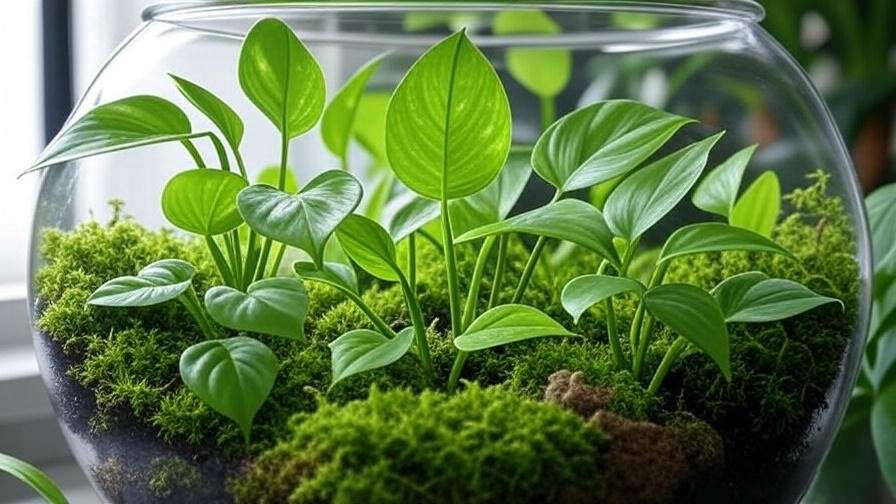Imagine transforming a tiny corner of your home into a lush, green oasis with just a glass container and a few hardy plants! 🌸 Terrarium plants are the perfect way for beginners to dip their toes into plant care, offering a low-maintenance, space-saving solution that brings nature indoors. Whether you live in a cozy apartment or simply want a low-effort hobby, terrarium plants like pothos, fittonia, and mosses thrive in small, controlled environments with minimal care. In this comprehensive guide, written by a plant care expert with over a decade of experience designing vibrant terrariums, we’ll explore the best terrarium plants for beginners, how to choose them, and step-by-step tips to ensure they flourish. Get ready to create your own miniature jungle and solve the challenge of limited space with plants that are as forgiving as they are beautiful! 🌱
This article is designed to answer your questions about terrarium plants, from selecting the easiest species to setting up and maintaining your terrarium. Whether you’re a complete novice or a budding plant enthusiast, you’ll find actionable advice to make your terrarium thrive. Let’s dive into the world of terrariums and discover how these tiny ecosystems can bring joy and greenery to your life! 🌿
What Are Terrarium Plants? Understanding the Basics 🌱
Definition and Benefits of Terrarium Plants
Terrarium plants are small, slow-growing species that thrive in the confined, humid environments of glass containers. These plants are ideal for beginners because they require minimal upkeep, adapt well to low light, and fit perfectly in small spaces like desktops or shelves. Unlike traditional houseplants, terrarium plants often need less frequent watering and can handle the unique conditions of enclosed or semi-enclosed ecosystems.
Benefits of Terrarium Plants:
- Low Maintenance: Many terrarium plants, like pothos or peperomia, forgive occasional neglect, making them perfect for busy beginners.
- Space-Saving: Their compact size suits apartments, dorms, or offices.
- Aesthetic Appeal: Terrariums create stunning visual displays, combining plants, moss, and decor for a miniature forest vibe.
- Stress Relief: Caring for a terrarium is a calming, rewarding hobby that connects you with nature.
Types of Terrariums for Beginners
Terrariums come in two main types: open and closed. Each affects plant selection and care.
- Closed Terrariums: These sealed containers trap humidity, creating a tropical environment ideal for plants like fittonia or ferns. They require less frequent watering but need occasional ventilation to prevent mold.
- Open Terrariums: With open tops, these allow air circulation, suiting plants like air plants or haworthia that prefer drier conditions. They need slightly more frequent watering but are easier to maintain for beginners.
Key Considerations:
- Humidity: Closed terrariums suit high-humidity plants; open ones work for drought-tolerant species.
- Light: Most terrarium plants prefer indirect light, making them ideal for low-light spaces.
- Container Size: Smaller containers limit plant size, so choose compact varieties.
Top 10 Low-Maintenance Terrarium Plants for Beginners 🌿
Here’s a curated list of the best terrarium plants for beginners, selected for their ease of care, adaptability, and visual appeal. Each plant is paired with practical care tips to ensure success.
1. Pothos (Epipremnum aureum) 🌱
- Why It’s Great: Known as “devil’s ivy,” pothos is nearly indestructible. It tolerates low light, grows slowly, and is easy to propagate, making it a top pick for terrariums.
- Care Tips:
- Light: Bright, indirect light or low light.
- Watering: Water when the soil feels dry; avoid soggy roots.
- Pruning: Trim long vines to maintain size.
- Expert Insight: Pothos’ heart-shaped leaves add a lush, trailing effect to terrariums.
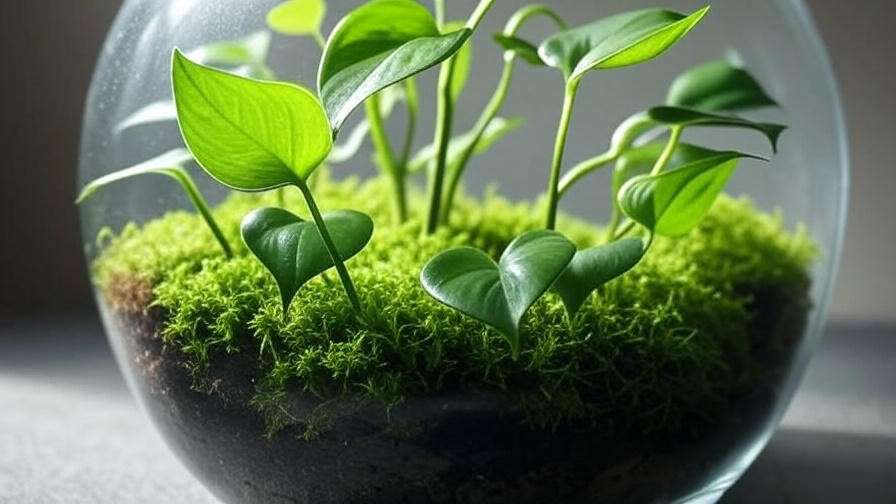
2. Fittonia (Nerve Plant) 🌸
- Why It’s Great: Fittonia’s vibrant, veined leaves (in green, pink, or white) thrive in the humid conditions of closed terrariums, adding a pop of color.
- Care Tips:
- Light: Indirect light; direct sun burns leaves.
- Watering: Mist regularly to maintain humidity; keep soil moist but not waterlogged.
- Tip: Pinch back stems to encourage bushy growth.
- Expert Insight: Fittonia wilts dramatically when thirsty but bounces back quickly after watering.
3. Peperomia 🌿
- Why It’s Great: With over 1,000 varieties, peperomia offers diverse leaf textures and colors. Its compact size and drought tolerance make it ideal for terrariums.
- Care Tips:
- Light: Bright, indirect light.
- Watering: Water sparingly; let soil dry between waterings.
- Soil: Use well-draining potting mix.
- Expert Insight: Peperomia obtusifolia (baby rubber plant) is a beginner favorite for its thick, glossy leaves.
4. Air Plants (Tillandsia) 🌬️
- Why It’s Great: Air plants don’t need soil, making them perfect for open terrariums. Their unique shapes add a modern, sculptural look.
- Care Tips:
- Light: Bright, indirect light.
- Watering: Soak in water for 20–30 minutes weekly; shake off excess water.
- Airflow: Ensure good air circulation to prevent rot.
- Expert Insight: Display air plants on driftwood or stones for a striking effect.
5. Ferns (e.g., Button Fern) 🌿
- Why It’s Great: Ferns like the button fern (Pellaea rotundifolia) thrive in low light and add a delicate, feathery texture to closed terrariums.
- Care Tips:
- Light: Low to medium indirect light.
- Watering: Keep soil consistently moist but not soggy.
- Tip: Mist fronds to boost humidity.
- Expert Insight: Ferns are sensitive to overwatering; check soil moisture before watering.
6. Mosses (e.g., Cushion Moss) 🌱
- Why It’s Great: Mosses create a lush, carpet-like base in terrariums and require minimal care, thriving in humid, low-light conditions.
- Care Tips:
- Light: Low to medium indirect light.
- Watering: Mist lightly every few days; avoid soaking.
- Tip: Use tweezers to arrange moss for a polished look.
- Expert Insight: Combine moss with taller plants for a layered, natural aesthetic.
7. Baby Tears (Soleirolia soleirolii) 🌸
- Why It’s Great: This ground cover forms a dense mat of tiny leaves, perfect for filling gaps in terrariums.
- Care Tips:
- Light: Bright, indirect light.
- Watering: Keep soil moist; high humidity is essential.
- Pruning: Trim to control spread.
- Expert Insight: Baby tears pair beautifully with taller plants like pothos.
8. Spider Plant (Chlorophytum comosum) 🌿
- Why It’s Great: Spider plants are hardy and produce plantlets (babies) for easy propagation, adding a playful element to terrariums.
- Care Tips:
- Light: Bright, indirect light.
- Watering: Water when soil is dry; avoid overwatering.
- Tip: Plantlets can be snipped and propagated in water.
- Expert Insight: Choose variegated varieties for extra visual interest.
9. Haworthia 🌵
- Why It’s Great: This small succulent thrives in open terrariums, tolerating neglect and adding a desert vibe.
- Care Tips:
- Light: Bright light; some direct sun is okay.
- Watering: Water sparingly every 2–3 weeks.
- Soil: Use a cactus mix for drainage.
- Expert Insight: Haworthia’s rosette shape complements modern terrarium designs.
10. Miniature Orchids 🌺
- Why It’s Great: Compact orchids like Phalaenopsis minis bring elegance and blooms to terrariums without overwhelming small spaces.
- Care Tips:
- Light: Bright, indirect light.
- Watering: Water lightly; avoid wet roots.
- Humidity: High humidity for closed terrariums.
- Expert Insight: Use orchid bark as a substrate for best results.
How to Choose the Right Terrarium Plants for Your Space 🌿
Assessing Your Environment
Selecting the right terrarium plants starts with understanding your space.
- Light: Evaluate natural light in your home. North-facing windows provide low light, ideal for ferns and mosses, while east-facing windows suit pothos or peperomia. If natural light is limited, consider LED grow lights (aim for 6500K for optimal plant growth).
- Space: Measure your terrarium’s dimensions. Small containers (under 6 inches) suit mosses or baby tears, while larger ones (12+ inches) can house pothos or spider plants.
- Humidity: Closed terrariums maintain high humidity, perfect for fittonia or ferns. Open terrariums suit air plants or haworthia.
Plant Compatibility
To create a thriving terrarium, choose plants with similar needs:
- Pair high-humidity plants (e.g., fittonia, ferns) in closed terrariums.
- Combine drought-tolerant plants (e.g., haworthia, air plants) in open terrariums.
- Avoid overcrowding; leave space for air circulation and growth.
Expert Tip: Test plant compatibility by grouping them in a temporary setup before planting permanently.
Step-by-Step Guide to Setting Up Your Terrarium 🌱
Materials You’ll Need
To build a beginner-friendly terrarium, gather these essentials:
- Glass container (jar, bowl, or vase)
- Substrate: Potting soil, sand, or orchid bark
- Activated charcoal (for odor control)
- Decor: Stones, driftwood, or figurines
- Tools: Tweezers, small trowel, spray bottle
- Plants from the list above
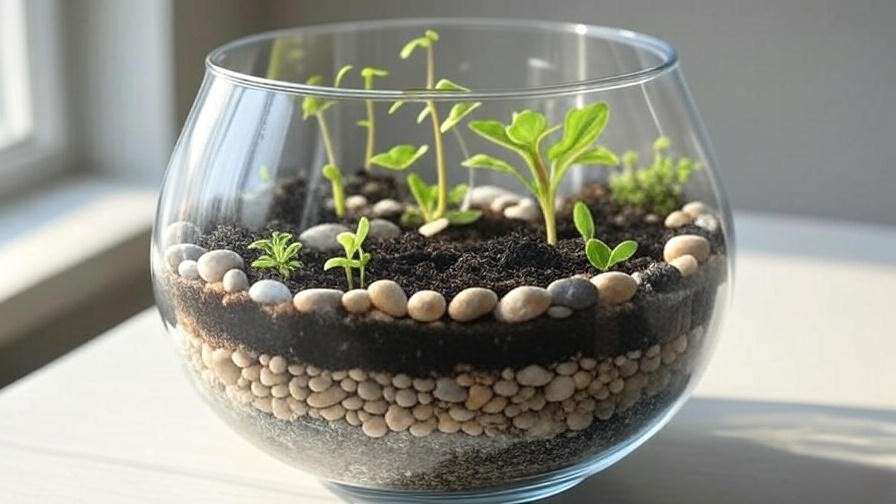
Expert Tip: Choose a container with a wide opening for easier planting and maintenance.
Building Your Terrarium
- Clean the Container: Wash and dry the glass to prevent bacteria.
- Layer the Substrate:
- Add a 1-inch layer of pebbles or sand.
- Sprinkle activated charcoal to keep the terrarium fresh.
- Add 2–3 inches of potting soil or moss as the planting base.
- Plant Your Terrarium:
- Use tweezers to place small plants like moss or baby tears.
- Dig small holes for rooted plants like pothos or fittonia.
- Press soil gently to secure plants.
- Add Decor: Arrange stones, driftwood, or tiny figurines for a polished look.
- Water Lightly: Mist plants or add a small amount of water to settle the soil.
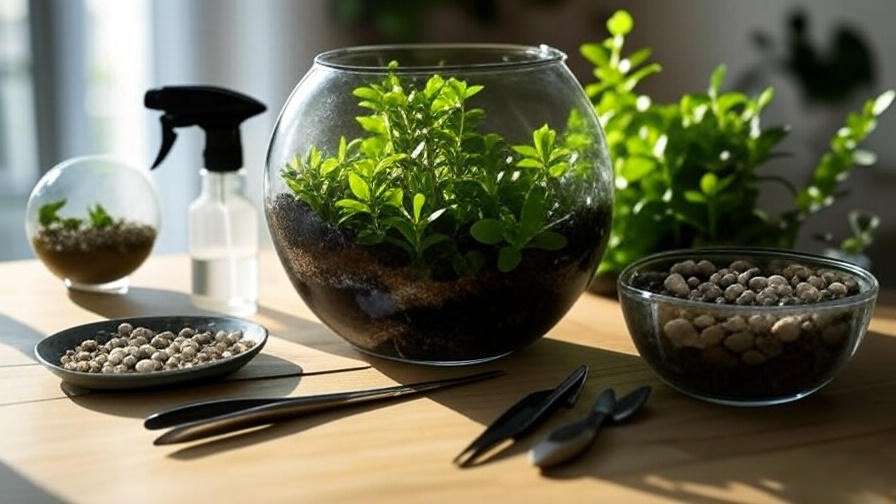
Placement and Maintenance
- Placement: Place your terrarium in indirect light, away from drafts or heat sources like radiators.
- Maintenance Checklist:
- Check soil moisture weekly; water sparingly.
- Mist closed terrariums to maintain humidity.
- Clean glass with a damp cloth to remove dust.
- Prune dead leaves to prevent mold.
Expert Insight: Rotate your terrarium every few weeks to ensure even light exposure.
Common Terrarium Plant Care Mistakes to Avoid 🚫
Even with low-maintenance terrarium plants, beginners can make mistakes that hinder growth or harm their miniature ecosystems. Here are the most common pitfalls and how to avoid them, ensuring your terrarium thrives.
Overwatering
The Problem: Overwatering is the top reason terrarium plants fail. Excess moisture leads to root rot, mold, or fungal issues, especially in closed terrariums where humidity is already high.
Signs of Overwatering:
- Yellowing or wilting leaves despite moist soil.
- Mold or algae on soil or glass.
- A musty smell inside the terrarium.
How to Fix It:
- Check soil moisture before watering; it should feel dry to the touch for most plants.
- Use a spray bottle to mist lightly rather than pouring water.
- For closed terrariums, open the lid for a few hours weekly to ventilate excess moisture.
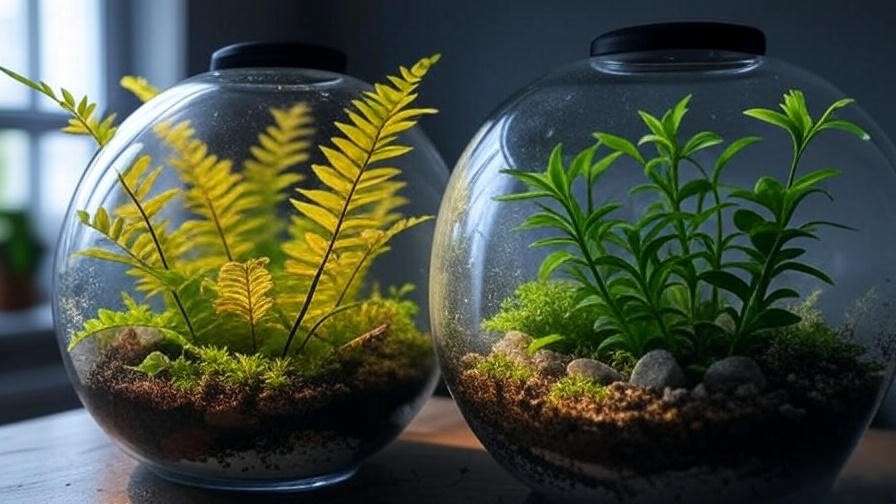
Expert Tip: Invest in a small moisture meter to gauge soil dampness accurately, especially for plants like pothos or peperomia.
Poor Light Management
The Problem: Incorrect lighting can stunt growth or burn delicate terrarium plants. Many beginners place terrariums in direct sunlight, assuming plants need intense light, or in dark corners where they can’t photosynthesize.
Signs of Poor Light:
- Leggy, stretched growth (too little light).
- Brown, crispy leaves (too much direct sun).
- Faded colors or slow growth.
How to Fix It:
- Place terrariums in bright, indirect light, such as near a north- or east-facing window.
- For low-light spaces, use a full-spectrum LED grow light (6500K) for 8–12 hours daily.
- Rotate the terrarium periodically to ensure all plants get even light exposure.
Expert Insight: For plants like ferns or mosses, filtered light through sheer curtains mimics their natural forest-floor habitat.
Neglecting Humidity
The Problem: Many terrarium plants, like fittonia or baby tears, require high humidity to thrive. In open terrariums or dry climates, neglecting humidity can cause leaves to curl or dry out.
Signs of Low Humidity:
- Crispy leaf edges or drooping foliage.
- Slow growth in humidity-loving plants.
How to Fix It:
- For closed terrariums, mist plants lightly every few days to maintain humidity levels (70–80%).
- In open terrariums, place a small dish of water nearby or group plants to create a microclimate.
- Use a hygrometer to monitor humidity, aiming for levels suited to your plants.
Expert Solution: If humidity is consistently low, consider a small humidifier for the room where your terrarium is placed.
Expert Tips for Long-Term Terrarium Success 🌿
To keep your terrarium looking vibrant and healthy for years, follow these expert-backed strategies, honed from years of hands-on experience in plant care and terrarium design.
- Rotate for Even Growth: Turn your terrarium every 1–2 weeks to ensure all plants receive equal light, preventing lopsided growth.
- Use Distilled Water: Tap water can leave mineral deposits on glass or soil, affecting plant health. Distilled or rainwater is ideal for misting and watering.
- Prune Regularly: Trim dead leaves or overgrown stems with small scissors to maintain shape and prevent decay. For plants like pothos or spider plants, pruning encourages bushier growth.
- Monitor for Pests: While rare in terrariums, pests like fungus gnats can appear. Use neem oil (diluted 1:10 with water) as a natural remedy, applied with a cotton swab.
- Refresh Substrates: Every 6–12 months, replace the top layer of soil or moss to prevent compaction and maintain nutrient availability.
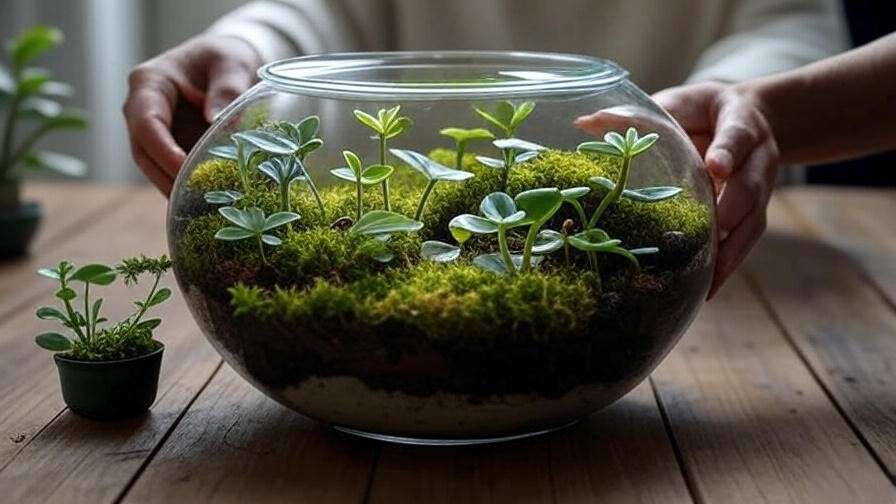
Expert Insight: Keep a terrarium journal to track watering, pruning, and plant growth. This helps identify patterns and fine-tune care routines.
FAQs About Terrarium Plants ❓
Here are answers to common questions beginners ask about terrarium plants, addressing their needs and concerns directly.
- What are the easiest terrarium plants for beginners?
Pothos, fittonia, and cushion moss are among the easiest due to their forgiving nature and adaptability to low light and varying humidity levels. - Can I mix different types of plants in one terrarium?
Yes, as long as they share similar light and humidity needs. For example, pair fittonia and ferns in a closed terrarium, or haworthia and air plants in an open one. - How often should I water my terrarium plants?
Watering frequency depends on the plant and terrarium type. Closed terrariums may need watering every 2–3 weeks, while open terrariums require it every 1–2 weeks. Always check soil moisture first. - Do terrarium plants need fertilizer?
Rarely. Terrarium plants grow slowly and need minimal nutrients. If growth seems sluggish, use a diluted liquid fertilizer (1/4 strength) once every 2–3 months. - How do I prevent mold in a closed terrarium?
Ventilate the terrarium weekly, avoid overwatering, and use activated charcoal in the substrate to absorb excess moisture.
Conclusion: Start Your Terrarium Journey Today! 🌱
Terrarium plants offer a delightful way to bring greenery into small spaces, even for those with no prior plant care experience. From the resilient pothos to the vibrant fittonia, these low-maintenance plants make it easy to create a thriving miniature ecosystem. By choosing the right plants, setting up your terrarium thoughtfully, and avoiding common mistakes, you can enjoy a lush, green display that enhances your home and soothes your soul. 🌿
Ready to start? Grab a glass container, pick a few beginner-friendly plants from our list, and let your creativity shine. Share your terrarium photos in the comments or tag us on social media—we’d love to see your miniature jungle! For more plant care tips, explore our related articles on indoor gardening and soil selection. Happy planting! 🌸

